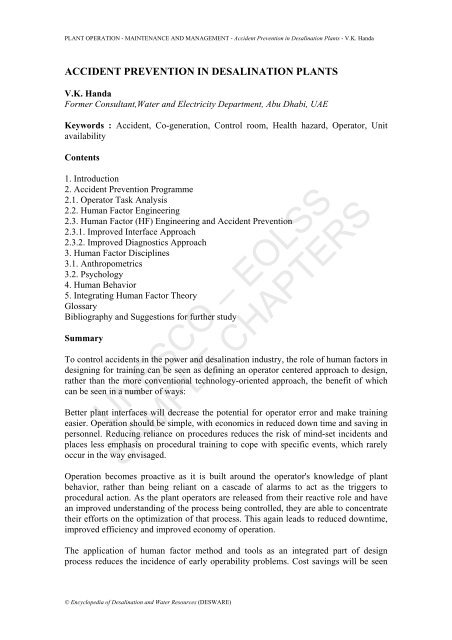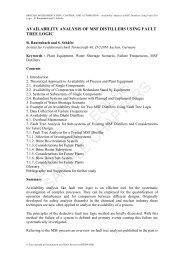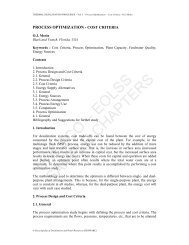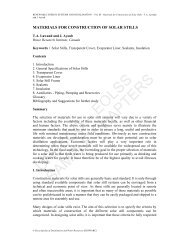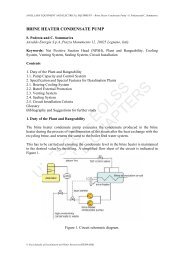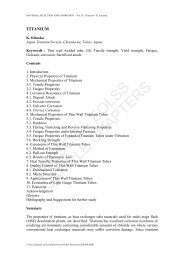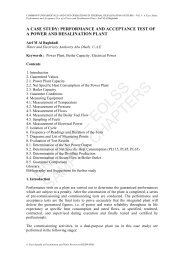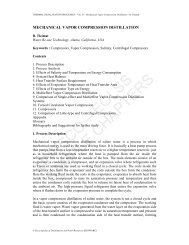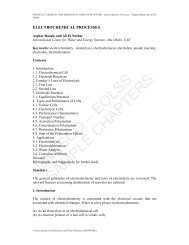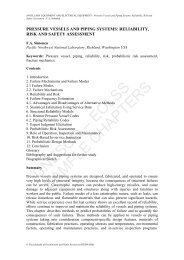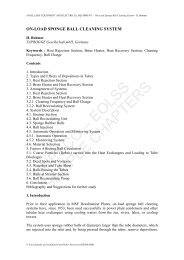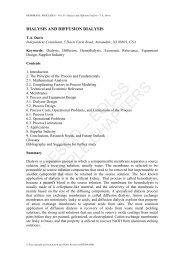Accident Prevention in Desalination Plants - Encyclopedia of ...
Accident Prevention in Desalination Plants - Encyclopedia of ...
Accident Prevention in Desalination Plants - Encyclopedia of ...
You also want an ePaper? Increase the reach of your titles
YUMPU automatically turns print PDFs into web optimized ePapers that Google loves.
PLANT OPERATION - MAINTENANCE AND MANAGEMENT - <strong>Accident</strong> <strong>Prevention</strong> <strong>in</strong> Desal<strong>in</strong>ation <strong>Plants</strong> - V.K. Handa<br />
ACCIDENT PREVENTION IN DESALINATION PLANTS<br />
V.K. Handa<br />
Former Consultant,Water and Electricity Department, Abu Dhabi, UAE<br />
Keywords : <strong>Accident</strong>, Co-generation, Control room, Health hazard, Operator, Unit<br />
availability<br />
Contents<br />
1. Introduction<br />
2. <strong>Accident</strong> <strong>Prevention</strong> Programme<br />
2.1. Operator Task Analysis<br />
2.2. Human Factor Eng<strong>in</strong>eer<strong>in</strong>g<br />
2.3. Human Factor (HF) Eng<strong>in</strong>eer<strong>in</strong>g and <strong>Accident</strong> <strong>Prevention</strong><br />
2.3.1. Improved Interface Approach<br />
2.3.2. Improved Diagnostics Approach<br />
3. Human Factor Discipl<strong>in</strong>es<br />
3.1. Anthropometrics<br />
3.2. Psychology<br />
4. Human Behavior<br />
5. Integrat<strong>in</strong>g Human Factor Theory<br />
Glossary<br />
Bibliography and Suggestions for further study<br />
Summary<br />
To control accidents <strong>in</strong> the power and desal<strong>in</strong>ation <strong>in</strong>dustry, the role <strong>of</strong> human factors <strong>in</strong><br />
design<strong>in</strong>g for tra<strong>in</strong><strong>in</strong>g can be seen as def<strong>in</strong><strong>in</strong>g an operator centered approach to design,<br />
rather than the more conventional technology-oriented approach, the benefit <strong>of</strong> which<br />
can be seen <strong>in</strong> a number <strong>of</strong> ways:<br />
Better plant <strong>in</strong>terfaces will decrease the potential for operator error and make tra<strong>in</strong><strong>in</strong>g<br />
easier. Operation should be simple, with economics <strong>in</strong> reduced down time and sav<strong>in</strong>g <strong>in</strong><br />
personnel. Reduc<strong>in</strong>g reliance on procedures reduces the risk <strong>of</strong> m<strong>in</strong>d-set <strong>in</strong>cidents and<br />
places less emphasis on procedural tra<strong>in</strong><strong>in</strong>g to cope with specific events, which rarely<br />
occur <strong>in</strong> the way envisaged.<br />
UNESCO – EOLSS<br />
SAMPLE CHAPTERS<br />
Operation becomes proactive as it is built around the operator's knowledge <strong>of</strong> plant<br />
behavior, rather than be<strong>in</strong>g reliant on a cascade <strong>of</strong> alarms to act as the triggers to<br />
procedural action. As the plant operators are released from their reactive role and have<br />
an improved understand<strong>in</strong>g <strong>of</strong> the process be<strong>in</strong>g controlled, they are able to concentrate<br />
their efforts on the optimization <strong>of</strong> that process. This aga<strong>in</strong> leads to reduced downtime,<br />
improved efficiency and improved economy <strong>of</strong> operation.<br />
The application <strong>of</strong> human factor method and tools as an <strong>in</strong>tegrated part <strong>of</strong> design<br />
process reduces the <strong>in</strong>cidence <strong>of</strong> early operability problems. Cost sav<strong>in</strong>gs will be seen<br />
© <strong>Encyclopedia</strong> <strong>of</strong> Desal<strong>in</strong>ation and Water Resources (DESWARE)
PLANT OPERATION - MAINTENANCE AND MANAGEMENT - <strong>Accident</strong> <strong>Prevention</strong> <strong>in</strong> Desal<strong>in</strong>ation <strong>Plants</strong> - V.K. Handa<br />
downstream, <strong>in</strong> fewer errors and less likelihood <strong>of</strong> costly design changes, and reduced<br />
number <strong>of</strong> accidents.<br />
1. Introduction<br />
As electric utility companies enter the era <strong>of</strong> year 2000, they f<strong>in</strong>d themselves <strong>in</strong> an<br />
expand<strong>in</strong>g arena <strong>of</strong> competition from co-generation plants and <strong>in</strong>dependent power and<br />
water producers to which they must aggressively respond, <strong>in</strong> order to rema<strong>in</strong> viable<br />
entities. One result <strong>of</strong> this new competition is the need to generate the most economic<br />
value out <strong>of</strong> available resources.<br />
Aspects <strong>of</strong> ma<strong>in</strong>tenance, unit availability, operator staff<strong>in</strong>g together represent an<br />
economic risk for a power and/or desal<strong>in</strong>ation utility. This is just one form <strong>of</strong> risk to<br />
which the utility is exposed, and there are other risks which the utility must address.<br />
These <strong>in</strong>clude worker safety, public health and safety, and loss <strong>of</strong> property/capital.<br />
These risks result from components either fail<strong>in</strong>g to operate or operat<strong>in</strong>g improperly.<br />
Plant model<strong>in</strong>g demonstrates that lack <strong>of</strong> proper operator action is a significant risk,<br />
need<strong>in</strong>g mitigation <strong>in</strong> power/water produc<strong>in</strong>g plants. A great emphasis has been laid on<br />
<strong>in</strong>vestigat<strong>in</strong>g methods <strong>of</strong> qualify<strong>in</strong>g the risk <strong>in</strong> water desal<strong>in</strong>ation plants and <strong>of</strong><br />
controll<strong>in</strong>g accidents/risk through improved ma<strong>in</strong>tenance, <strong>in</strong>spection/test<strong>in</strong>g and<br />
mach<strong>in</strong>e/operator <strong>in</strong>terface, <strong>in</strong> order to reduce lost man-mach<strong>in</strong>e hours.<br />
One such group <strong>in</strong>volved <strong>in</strong> accident prevention and control <strong>of</strong> risks is "The ASME<br />
Research Task Force on Risk Based Inspection Guidel<strong>in</strong>e", formed dur<strong>in</strong>g 1986 and<br />
1987. This task force produces guidel<strong>in</strong>es on the selection <strong>of</strong> <strong>in</strong>service <strong>in</strong>spection,<br />
techniques, frequency and scope, based upon the risk which the associated<br />
failure/accident would present. From the 1993 ASME report, it became evident that<br />
operator action could significantly reduce the risk <strong>of</strong> accident to a plant, and the further<br />
risk <strong>of</strong> component failures, and mitigate failure <strong>of</strong> control components.<br />
2. <strong>Accident</strong> <strong>Prevention</strong> Programme<br />
The accident-prevention program consists <strong>of</strong> three sub-programs: (1) plant failure data<br />
development; (2) system availability analysis; (3) operator task analysis. The<br />
<strong>in</strong>formation gathered, personnel <strong>in</strong>terviewed and documents reviewed are very similar<br />
for each sub-program. Substantial sav<strong>in</strong>gs and improved consistency can be achieved by<br />
utiliz<strong>in</strong>g the same personnel to do all three sub-programs simultaneously.<br />
UNESCO – EOLSS<br />
SAMPLE CHAPTERS<br />
The operator task analysis consists <strong>of</strong> three parts:<br />
• Functional/activity flow development.<br />
• Activity identification.<br />
• Manpower assessment.<br />
2.1. Operator Task Analysis<br />
The operator task analysis provides <strong>in</strong>sight <strong>in</strong>to the operation <strong>of</strong> the plant, and how the<br />
© <strong>Encyclopedia</strong> <strong>of</strong> Desal<strong>in</strong>ation and Water Resources (DESWARE)
PLANT OPERATION - MAINTENANCE AND MANAGEMENT - <strong>Accident</strong> <strong>Prevention</strong> <strong>in</strong> Desal<strong>in</strong>ation <strong>Plants</strong> - V.K. Handa<br />
design/reliability <strong>of</strong> the plant impacts the plant operation. The operator task analysis by<br />
shifts demonstrates the flexibility <strong>of</strong> the personnel, with a specific task element be<strong>in</strong>g<br />
done/checked by several different people, depend<strong>in</strong>g upon the crew. In addition to<br />
formal tra<strong>in</strong><strong>in</strong>g, operator tra<strong>in</strong><strong>in</strong>g <strong>in</strong>cludes an observation period when qualified<br />
operators are observed <strong>in</strong> action, and <strong>in</strong>dividual operator notes (at site observation) are<br />
developed.<br />
2.2. Human Factor Eng<strong>in</strong>eer<strong>in</strong>g<br />
The comb<strong>in</strong>ation <strong>of</strong>: (a) formal tra<strong>in</strong><strong>in</strong>g, (b) on site observation, (c) <strong>in</strong> depth<br />
responsibility/check<strong>in</strong>g produces a very reliable operat<strong>in</strong>g situation with a m<strong>in</strong>imum <strong>of</strong><br />
accidents. Errors by the operators and ma<strong>in</strong>ta<strong>in</strong>ers <strong>of</strong> modern, highly automated plants<br />
and control systems are still more likely than equipment failure. Human Factor (HF)<br />
eng<strong>in</strong>eers have traditionally reduced human error by improv<strong>in</strong>g usability through<br />
improvements <strong>in</strong> the user <strong>in</strong>terface. This is <strong>in</strong> response to the need to reduce costs by<br />
reduc<strong>in</strong>g operat<strong>in</strong>g staff and decreas<strong>in</strong>g downtime, without <strong>in</strong>creas<strong>in</strong>g operator error.<br />
HF eng<strong>in</strong>eer<strong>in</strong>g can now employ a range <strong>of</strong> tools and methods dur<strong>in</strong>g the design<br />
process. Thus the potential for human error can be ma<strong>in</strong>ta<strong>in</strong>ed at a low level, or even<br />
reduced for the follow<strong>in</strong>g reasons:<br />
• Methods and tools improve usability with lower capital <strong>in</strong>vestment.<br />
• Methods and tools can be utilized <strong>in</strong> the design <strong>of</strong> tra<strong>in</strong><strong>in</strong>g content and evaluation.<br />
2.3. Human Factor (HF) Eng<strong>in</strong>eer<strong>in</strong>g and <strong>Accident</strong> <strong>Prevention</strong><br />
The demands on operators <strong>of</strong> complex systems have not decreased with the proliferation<br />
<strong>of</strong> computer-based control and <strong>in</strong>strumentation. Greater automation, through the use <strong>of</strong><br />
s<strong>of</strong>tware and computer-based systems and more centralized control and surveillance,<br />
has been the major thrust <strong>in</strong> design changes. The role <strong>of</strong> operator can only be based on<br />
his or her human capabilities. Cost-cutt<strong>in</strong>g alternatives, such as reduced mann<strong>in</strong>g and<br />
shortened system downtime, have <strong>in</strong>creased the stresses on operat<strong>in</strong>g staff, and the<br />
probability for serious human error is as great as ever.<br />
-<br />
-<br />
-<br />
UNESCO – EOLSS<br />
SAMPLE CHAPTERS<br />
TO ACCESS ALL THE 9 PAGES OF THIS CHAPTER,<br />
Visit: http://www.desware.net/DESWARE-SampleAllChapter.aspx<br />
Bibliography and Suggestions for further study<br />
ASME (1990) Research Task Force on Risk Based Inspection Wash<strong>in</strong>gton, DC.<br />
CRTD American Society <strong>of</strong> Mechanical Eng<strong>in</strong>eers, 20(1).<br />
© <strong>Encyclopedia</strong> <strong>of</strong> Desal<strong>in</strong>ation and Water Resources (DESWARE)
PLANT OPERATION - MAINTENANCE AND MANAGEMENT - <strong>Accident</strong> <strong>Prevention</strong> <strong>in</strong> Desal<strong>in</strong>ation <strong>Plants</strong> - V.K. Handa<br />
Human Error. New York: Press Syndicate University <strong>of</strong> Cambridge.<br />
Human Error. Roskilde: National Laboratory, Denmark.<br />
Human Factors Society. Dayton, USA.<br />
Kirvan B (1991) A Guide to Task Analysis. London: Taylor and Francis.<br />
Pollis H Safety Management. Consultant health and safety, the General Electrical Company.<br />
S<strong>in</strong>gleton W T Human Operator <strong>in</strong> Complex Systems. London: Taylor and Francis.<br />
Willsey P T (1994) Control Upgrade Study for Huntley. EPRI report no. GS 6961, August, California.<br />
UNESCO – EOLSS<br />
SAMPLE CHAPTERS<br />
© <strong>Encyclopedia</strong> <strong>of</strong> Desal<strong>in</strong>ation and Water Resources (DESWARE)


